Development of Fast E-nose System for Early-Stage Diagnosis of Aphid-Stressed Tomato Plants
Abstract
1. Introduction
2. Methods and Materials
2.1. Experiment Design
2.2. Fabrication of E-nose System
2.3. E-nose Data Collection
2.4. GC-MS Detection
3. Results and Discussion
3.1. E-nose Sensor Response and Data Analysis
3.2. Determination of VOCs
3.3. Seasonal Effects on the VOC Profiles of Tomato Plants
4. Conclusions
Author Contributions
Funding
Acknowledgments
Conflicts of Interest
References
- Tolman, J.H.; McLeod, D.G.R.; Harris, C.R. Cost of crop losses in processing tomato and cabbages in southwestern Ontario due to insects, weeds and/or diseases. Can. J. Plant Sci. 2004, 84, 915–921. [Google Scholar] [CrossRef]
- Zee, F.; Judy, J.W. Micromachined polymer-based chemical gas sensor array. Sens. Actuators B Chem. 2001, 72, 120–128. [Google Scholar] [CrossRef]
- Park, C.S.; Lee, C.; Kwon, O.S. Conducting polymer based nanobiosensors. Polymers 2016, 8, 249. [Google Scholar] [CrossRef] [PubMed]
- Kumar, S.; Lahlali, R.; Liu, X.; Karunakaran, C. Infrared spectroscopy combined with imaging: A new developing analytical tool in health and plant science. Appl. Spectrosc. Rev. 2016, 51, 466–483. [Google Scholar] [CrossRef]
- Shokri, E.; Hosseini, M.; Faridbod, F.; Rahaie, M. Rapid pre-symptomatic recognition of tristeza viral RNA by a novel fluorescent self-dimerized DNA-silver nanocluster probe. RSC Adv. 2016, 6, 99437–99443. [Google Scholar] [CrossRef]
- Malik, H.J.; Raza, A.; Amin, I.; Scheffler, J.A.; Scheffler, B.E.; Brown, J.K.; Mansoor, S. RNAi-mediated mortality of the whitefly through transgenic expression of double-stranded RNA homologous to acetylcholinesterase and ecdysone receptor in tobacco plants. Sci. Rep. 2016, 6, 38469. [Google Scholar] [CrossRef] [PubMed]
- Kwon, J.Y.; Ryu, K.H.; Choi, S.H. Reverse transcription polymerase chain reaction-based system for simultaneous detection of multiple lily-infecting viruses. Plant Pathol. J. 2013, 29, 338–343. [Google Scholar] [CrossRef] [PubMed][Green Version]
- Raza, W.; Wang, J.; Wu, Y.; Ling, N.; Wei, Z.; Huang, Q.; Shen, Q. Effects of volatile organic compounds produced by Bacillus amyloliquefaciens on the growth and virulence traits of tomato bacterial wilt pathogen Ralstonia solanacearum. Appl. Microbiol. Biotechnol. 2016, 100, 7639–7650. [Google Scholar] [CrossRef] [PubMed]
- Zou, H.Q.; Li, S.; Huang, Y.H.; Liu, Y.; Bauer, R.; Peng, L.; Tao, O.; Yan, S.R.; Yan, Y.H. Rapid identification of Asteraceae plants with improved RBF-ANN classification models based on MOS sensor E-nose. Evid. Based Complement. Altern. Med. 2014, 2014, 425341. [Google Scholar] [CrossRef] [PubMed]
- Chang, K.P.P.; Zakaria, A.; Nasir, A.S.A.; Yusuf, N.; Thriumani, R.; Shakaff, A.Y.M.; Adom, A.H. Analysis and Feasibility Study of Plant Disease using E-Nose. In Proceedings of the 2014 IEEE International Conference on Control System, Computing and Engineering (ICCSCE 2014), Penang, Malaysia, 28–30 November 2014. [Google Scholar] [CrossRef]
- Borges, E.; Martins, C.B.C.; Silva, R.R.; Zarbin, P.H.G. Terpenoids dominate the bouquet of volatile organic compounds by Passiflora edulis in response to herbivory by Heliconius erato Phyllis (Lepidoptera: Nymphalidae). Arthropod Plant Interact. 2017, 12, 123. [Google Scholar] [CrossRef]
- Cui, S.Q.; Ling, P.; Zhu, H.P.; Keener, H.M. Plant pest detection using an artificial nose system: A review. Sensors 2018, 18, 378. [Google Scholar] [CrossRef] [PubMed]
- Xu, X.; Tian, F.; Yang, S.X.; Li, Q.; Yan, J.; Ma, J. A solid trap and thermal desorption system with application to a medical electronic nose. Sensors 2008, 8, 6885–6898. [Google Scholar] [CrossRef] [PubMed]
- Estefania Nunez Carmona, E.; Sberveglieri, V.; Ponzoni, A.; Galstyan, V.; Zappa, D.; Pulvirenti, A.; Comini, E. Detection of food and skin pathogen microbiota by means of an electronic nose based on metal oxide chemiresistors. Sens. Actuators B. Chem. 2017, 238, 1224–1230. [Google Scholar] [CrossRef]
- Xu, S.; Lü, E.; Lu, H.; Zhou, Z.; Wang, Y.; Yang, J.; Wang, Y. Quality detection of litchi stored in different environments using an electronic nose. Sensors 2016, 16, 852. [Google Scholar] [CrossRef] [PubMed]
- Messina, V.; Domínguez, P.G.; Sancho, A.M.; Walsöe de Reca, N.; Carrari, F.; Grigioni, G. Tomato quality during short-eerm storage assessed by colour and electronic nose. Int. J. Electrochem. 2012, 2012, 687429. [Google Scholar] [CrossRef]
- Xu, S.; Zhou, Z.; Li, K.; Jamir, S.M.; Luo, X.W. Recognition of the duration and prediction of insect prevalence of stored rough rice infested by the red flour beetle (Tribolium castaneum Herbst) using an electronic nose. Sensors 2017, 17, 688. [Google Scholar] [CrossRef] [PubMed]
- Liu, Q.; Zhao, N.; Zhou, D.; Sun, Y.; Sun, K.; Pan, K.; Tu, K. Discrimination and growth tracking of fungi contamination in peaches using electronic nose. Food Chem. 2018, 1, 226–234. [Google Scholar] [CrossRef] [PubMed]
- Gebicki, J.; Szulczynski, B. Discrimination of selected fungi species based on their odour profile using prototypes of electronic nose instruments. Measurement 2018, 116, 307–313. [Google Scholar] [CrossRef]
- Riedlmeier, M.; Ghirardo, A.; Wenig, M.; Knappe, C.; Koch, K.; Georgii, E.; Dey, S.; Parker, J.E.; Corina Vlot, J.S.A. Monoterpenes support systemic acquired resistance within and between plants. Plant Cell 2017, 29, 1440–1459. [Google Scholar] [CrossRef]
- Sasso, R.; Iodice, L.; Woodcock, C.M.; Pickett, J.A.; Guerrieri, E. Electrophysiological and behavioural response of Aphidius ervi (Hymenoptera: Braconidae) to tomato plant volatiles. Chemoecology 2009, 19, 195–201. [Google Scholar] [CrossRef]
- Wen, T.; Zheng, L.Z.; Dong, S.; Gong, Z.L.; Sang, M.X.; Long, X.Z.; Luo, M.; Peng, H.L. Rapid detection and classification of citrus fruits infestation by Bactrocera dorsalis (Hendel) based on electronic nose. Postharvest Biol. Technol. 2019, 147, 156–165. [Google Scholar] [CrossRef]
- Sun, Y.B.; Wang, J.; Cheng, S.M. Discrimination among tea plants either with different invasive times using MOS electronic nose combined with a new feature extraction method. Comput. Electron. Agric. 2017, 143, 293–301. [Google Scholar] [CrossRef]
- Sun, Y.B.; Wang, J.; Cheng, S.M.; Wang, Y.W. Detection of pest species with different ratios in tea plant based on electronic nose. Ann. Appl. Biol. 2019, 174, 209–218. [Google Scholar] [CrossRef]
- Sun, Y.B.; Wang, J.; Sun, L.; Cheng, S.M.; Xiao, Q. Evaluation of E-nose data analyses for discrimination of tea plants with different damage types. J. Plant Dis. Prot. 2019, 126, 29–38. [Google Scholar] [CrossRef]
- Mishra, G.; Srivastava, S.; Panda, B.K.; Mishra, H.N. Sensor array optimization and determination of rhyzopertha dominica infestation in wheat using hybrid neuro-fuzzy-assisted electronic nose analysis. Anal. Methods 2018, 10, 5687–5695. [Google Scholar] [CrossRef]
- Barbosa-Pereira, L.; Rojo-Poveda, O.; Ferrocino, I.; Giordano, M.; Zeppa, G. Assessment of volatile fingerprint by HS-SPME/GC-qMS and E-nose for the classification of cocoa bean shells using chemometrics. Food Res. Int. 2019, 123, 684–696. [Google Scholar] [CrossRef] [PubMed]
- Cui, S.Q.; Alfaro Inocente, E.A.; Zhu, H.P.; Acosta, N.; Ling, P.P.; Keener, H.M. Development of portable E-nose system for early diagnosis of insect-stressed tomato plants. In Proceedings of the 2018 ASABE Annual International Meeting 1800990, Detroit, MI, USA, 29 July–1 August 2018. [Google Scholar] [CrossRef]
- Gibson, R.W.; Pickett, J.A. Wild potato repels aphids by release of aphid alarm pheromone. Nature 1983, 302, 608–609. [Google Scholar] [CrossRef]
- Aharoni, A.; Giri, A.P.; Deuerlein, S.; Griepink, F.; de Kogel, W.J.; Verstappen, F.W.A.; Verhoeven, H.A.; Jongsma, M.A.; Schwab, W.; Bouwmeester, H.J. Terpenoid metabolism in wild-type and transgenic Arabidopsis plants. Plant Cell 2003, 15, 2866–2884. [Google Scholar] [CrossRef] [PubMed]
- Beale, M.H.; Birkett, M.A.; Bruce, T.J.A.; Chamberlain, K.; Field, L.M.; Huttly, A.K.; Martin, J.L.; Parker, R.; Phillips, A.L.; Pickett, J.A.; et al. Aphid alarm pheromone produced by transgenic plants affects aphid and parasitoid behavior. Proc. Natl. Acad. Sci. USA 2006, 103, 10509–10513. [Google Scholar] [CrossRef]
- Hatano, E.; Kunert, G.; Bartram, S.; Boland, W.; Gershenzon, J.; Weisser, W.W. Do aphid colonies amplify their emission of alarm pheromone? J. Chem. Ecol. 2008, 34, 1149–1152. [Google Scholar] [CrossRef]
- Staudt, M.; Jackson, B.; El-Aouni, H.; Buatois, B.; Lacroze, J.P.; Poëssel, J.L.; Sauge, M.H. Volatile organic compound emissions induced by the aphid Myzus persicae differ among resistant and susceptible peach cultivars and a wild relative. Tree Physiol. 2010, 30, 1320–1334. [Google Scholar] [CrossRef] [PubMed]
- Faraone, N.; Hillier, N.K.; Cutler, G.C. Plant Essential oil synthesize and antagonize toxicity of different conventional insecticides against Myzus persicae (Hemiptera:Aphididae). PLoS ONE 2015, 10, e0127774. [Google Scholar] [CrossRef] [PubMed]
- Dambolena, J.S.; Zunino, M.P.; Herrera, J.M.; Pizzolitto, R.P.; Areco, V.A.; Zygadlo, J.A. Terpenes: Natural products for controlling insects of importance to human health—A structure activity relationship study. Psyche (Camb. Mass.) 2016, 2016, 4595823. [Google Scholar] [CrossRef]
- Yang, Y.C.; Lee, H.S.; Lee, S.H.; Clark, J.M.; Ahn, Y.J. Ovicidal and adulticidal activities of Cinnamomum zeylanicum bark essential oil compounds and related compounds against Pediculus humanus capitis (Anoplura: Pediculicidae). Int. J. Parasitol. 2005, 35, 1595–1600. [Google Scholar] [CrossRef] [PubMed]
- Priestley, C.M.; Burgess, I.F.; Williamson, E.M. Lethality of essential oil constituents towards the human louse, Pediculus humanus, and its eggs. Fitoterapia 2006, 77, 303–309. [Google Scholar] [CrossRef] [PubMed]
- Yang, Y.C.; Lee, S.H.; Clark, J.M.; Ahn, Y.J. Ovicidal and adulticidal activities of origanum majorana essential oil constituents against insecticide-susceptible and pyrethroid/malathion-resistant Pediculus humanus capitis (Anoplura: Pediculidae). J. Agric. Food Chem. 2009, 57, 2282–2287. [Google Scholar] [CrossRef] [PubMed]
- Stökl, J.; Brodmann, J.; Dafni, A.; Ayasse, M.; Hansson, B.S. Smells like aphids: Orchid flowers mimic aphid alarm pheromones to attract hoverflies for pollination. Proc. R. Soc. B Biol. Sci. 2011, 278, 1216–1222. [Google Scholar] [CrossRef] [PubMed]
- Bleeker, P.M.; Diergaarde, P.J.; Ament, K.; Guerra, J.; Weidner, M.; Schütz, S.; de Both, M.T.J.; Haring, M.A.; Schuurink, R.C. Ther role of specific Tomato Volatiles in Tomato-Wgitefly Interaction. Plant Physiol. 2009, 151, 925–935. [Google Scholar] [CrossRef] [PubMed]
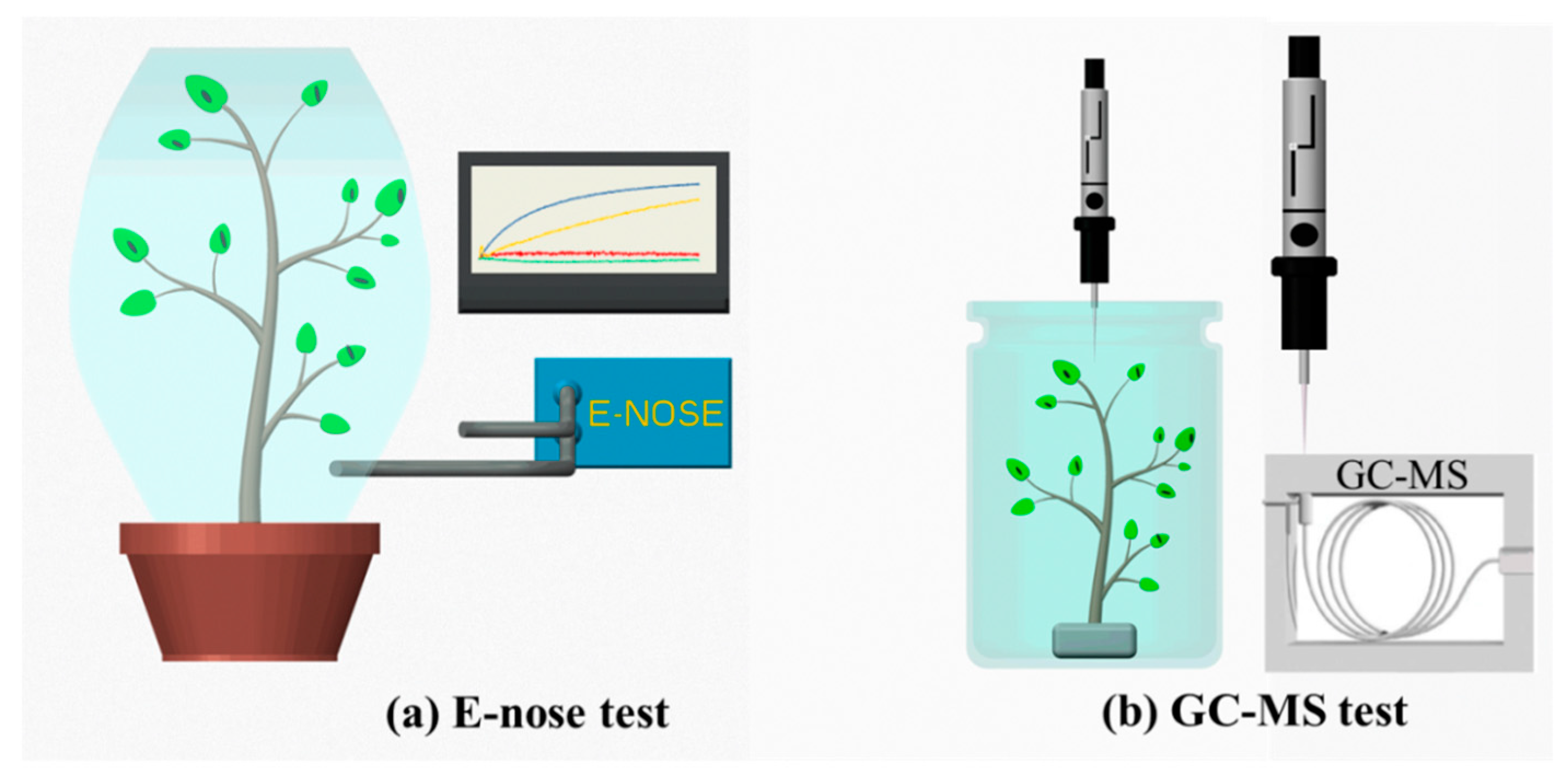

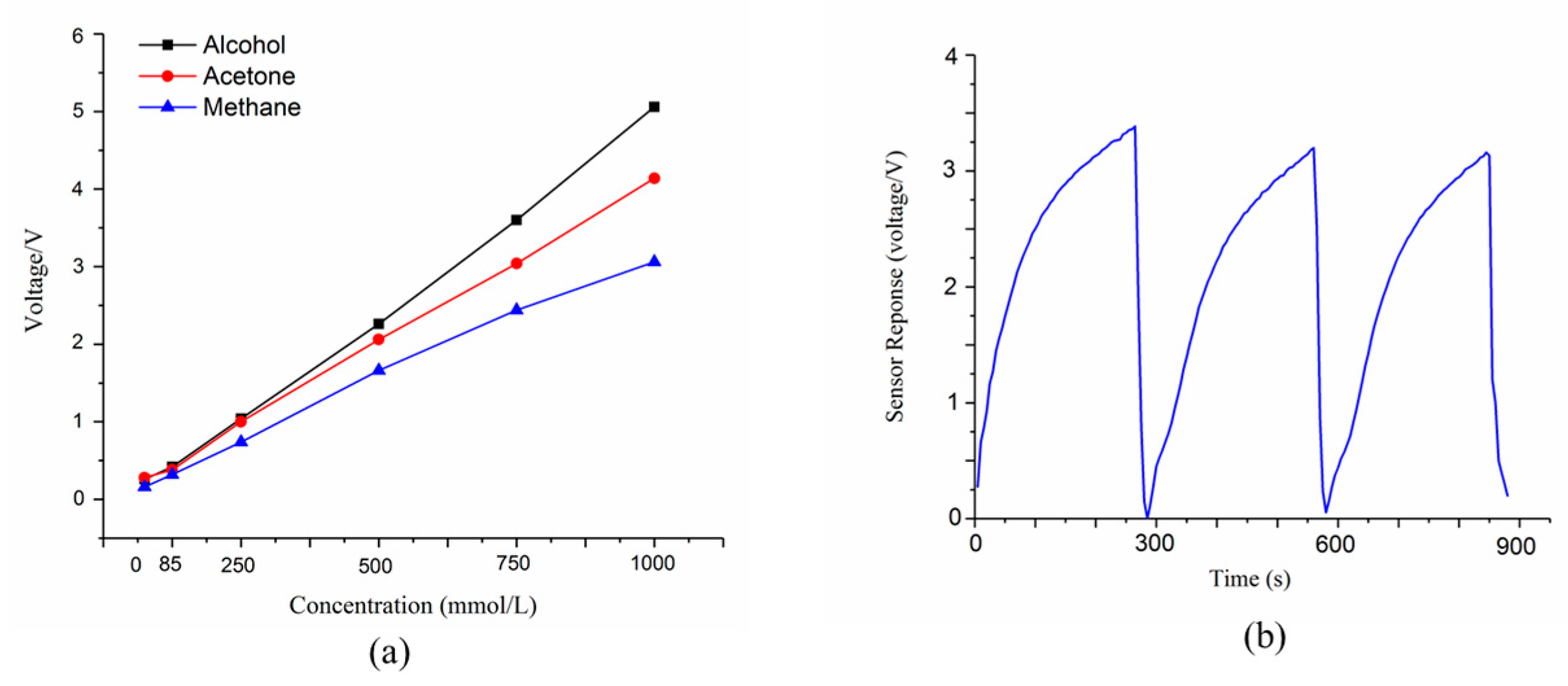

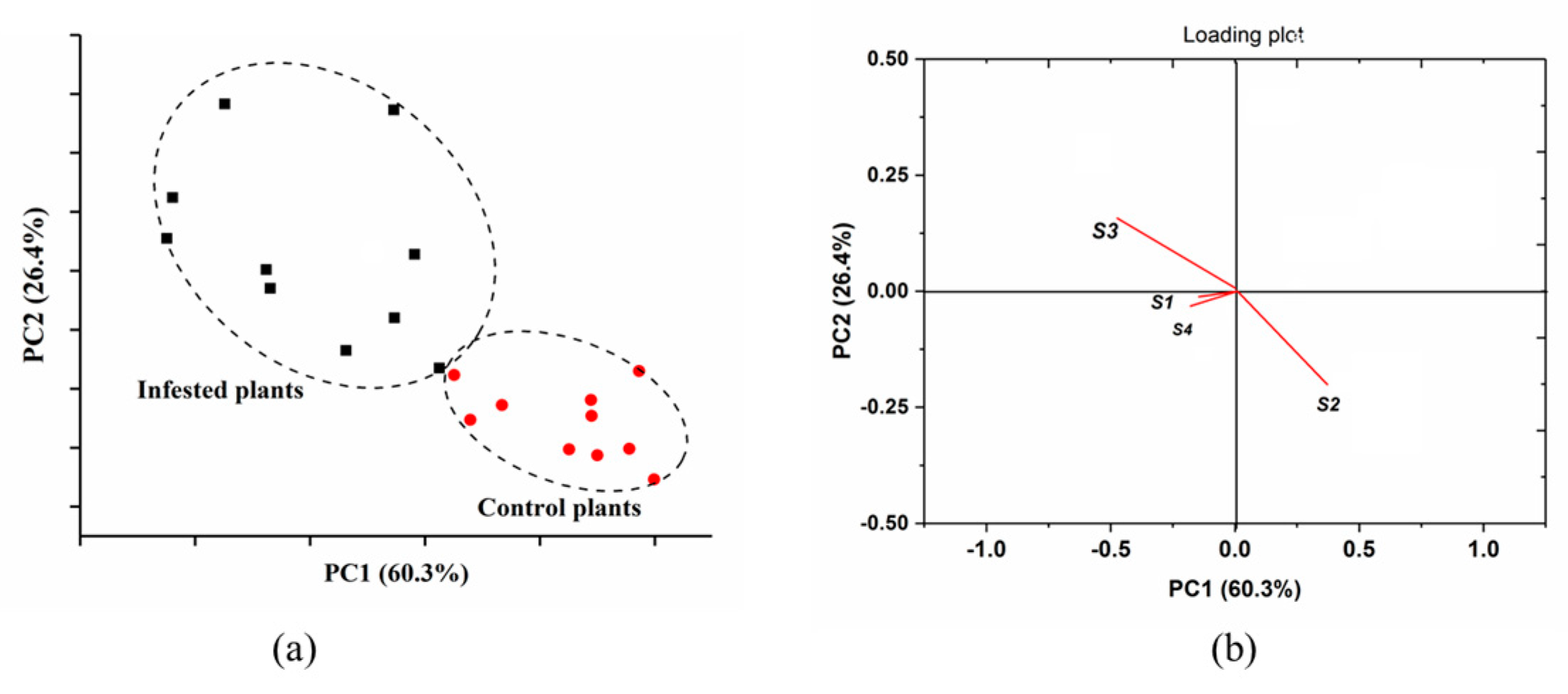
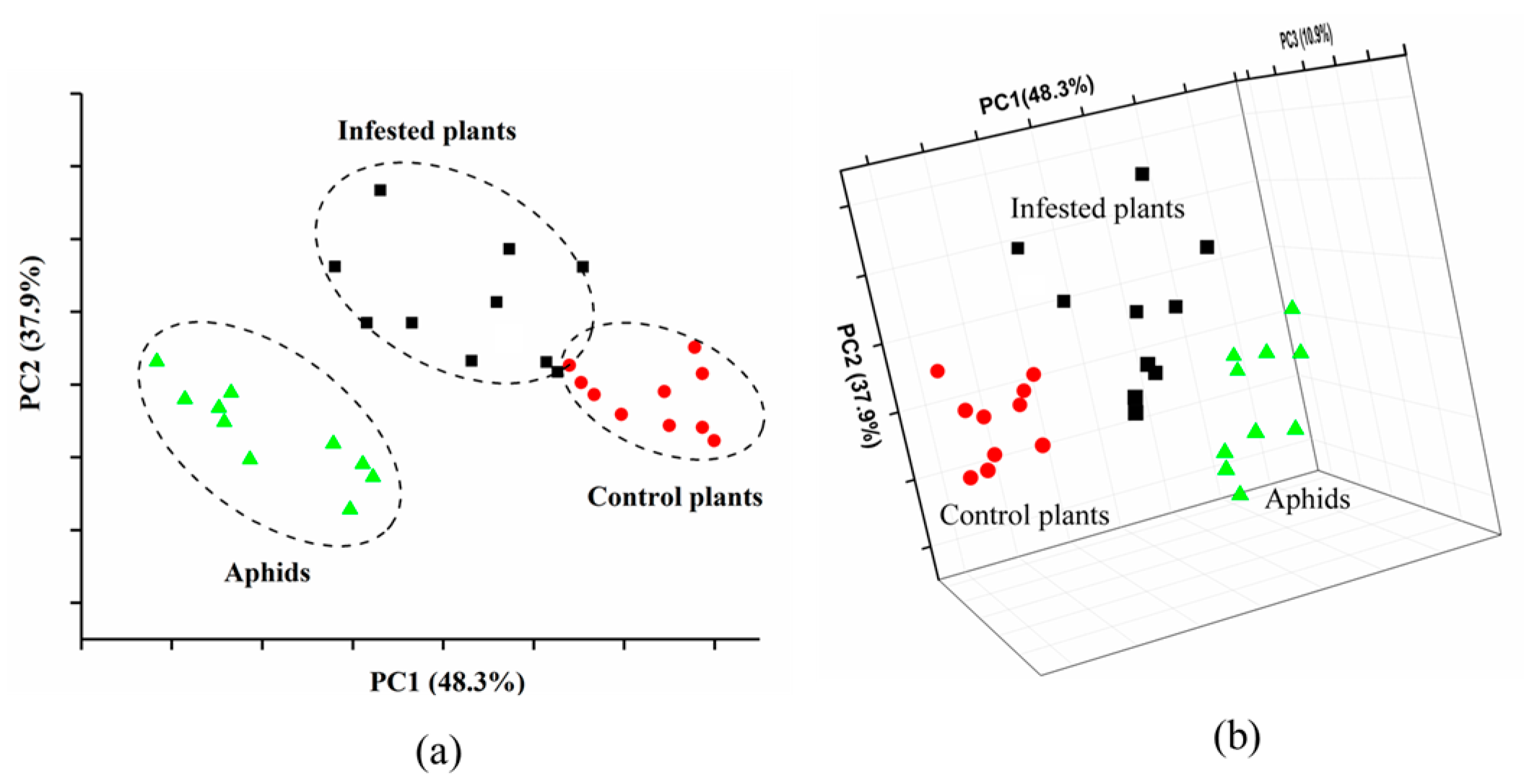
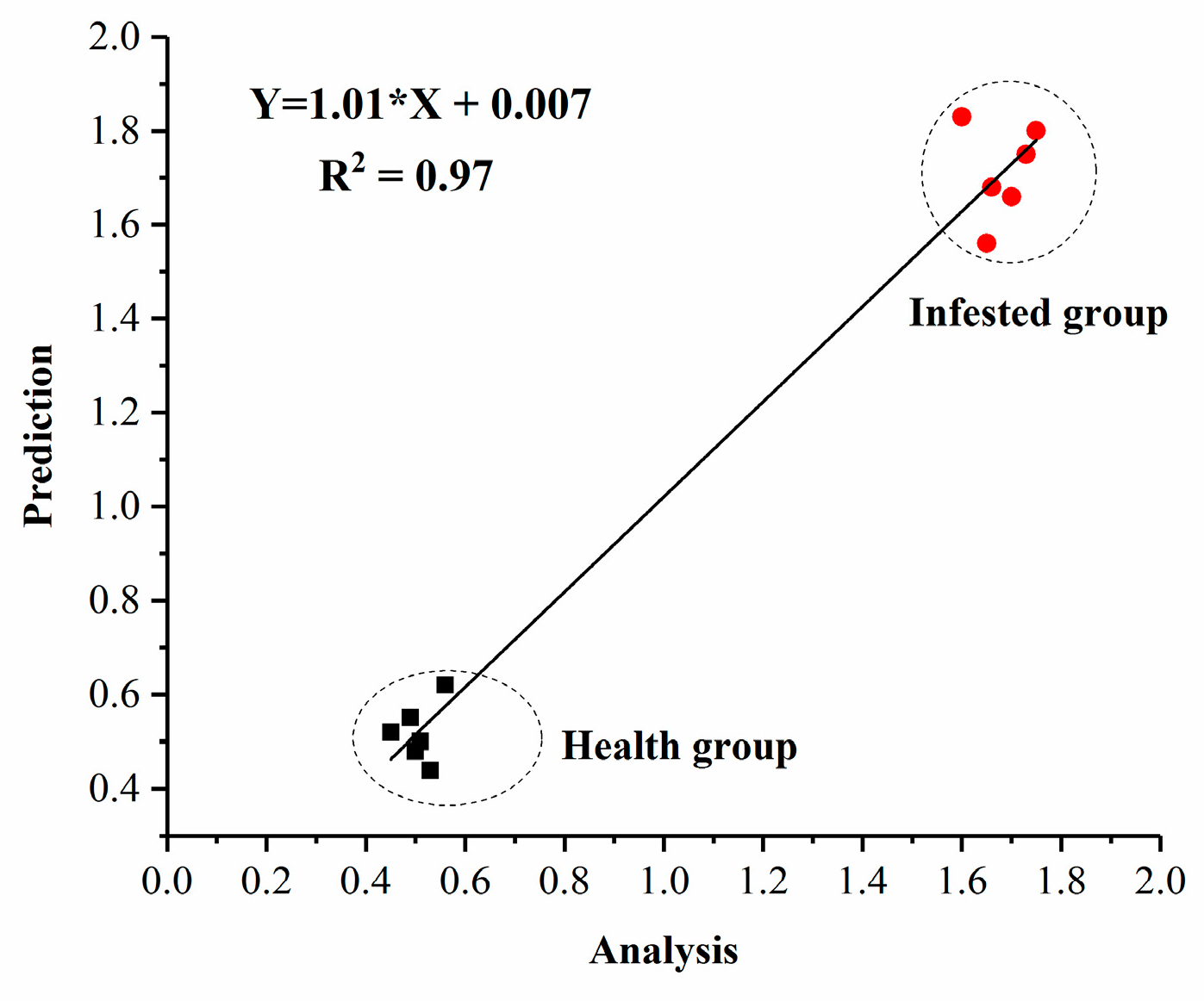
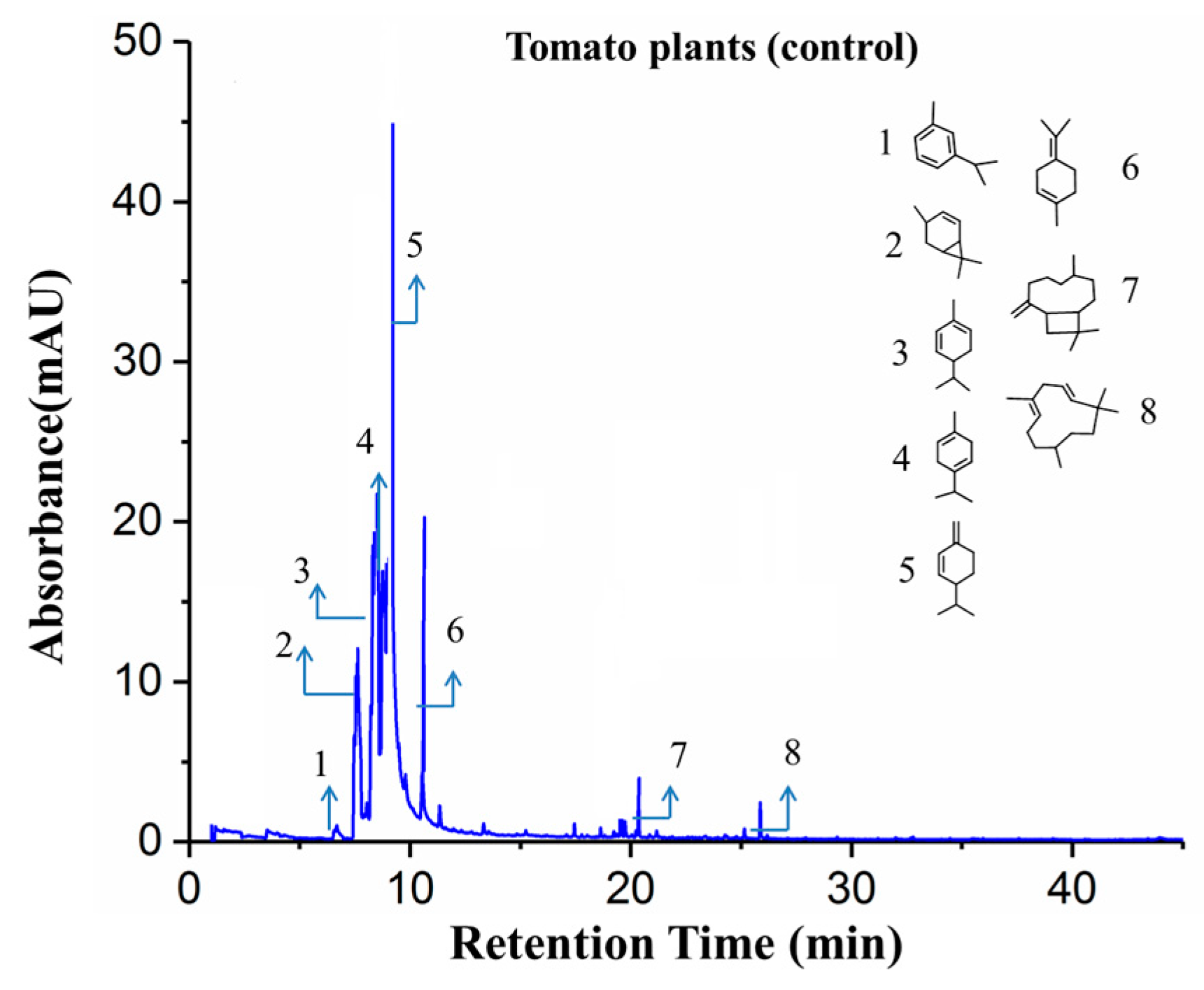
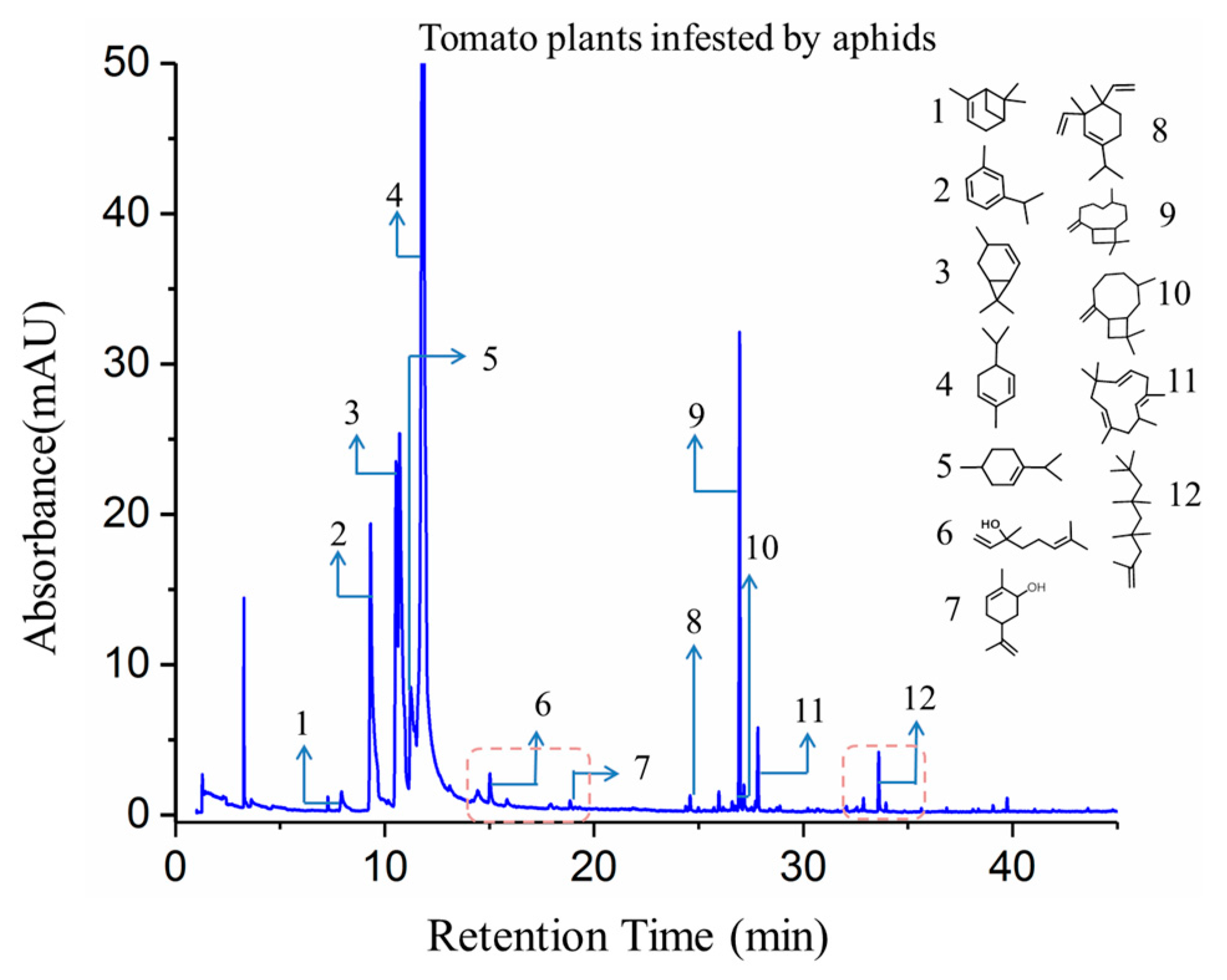
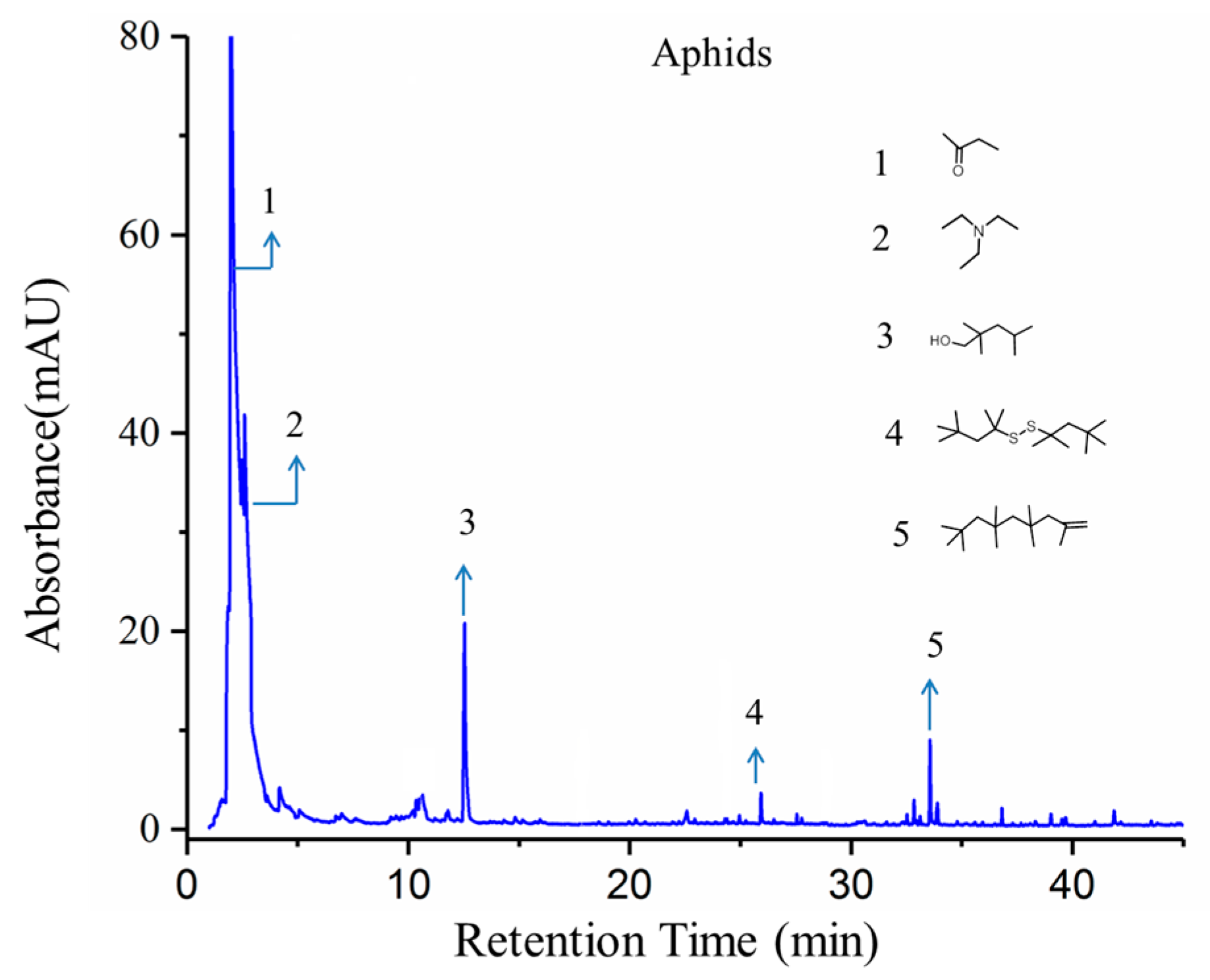
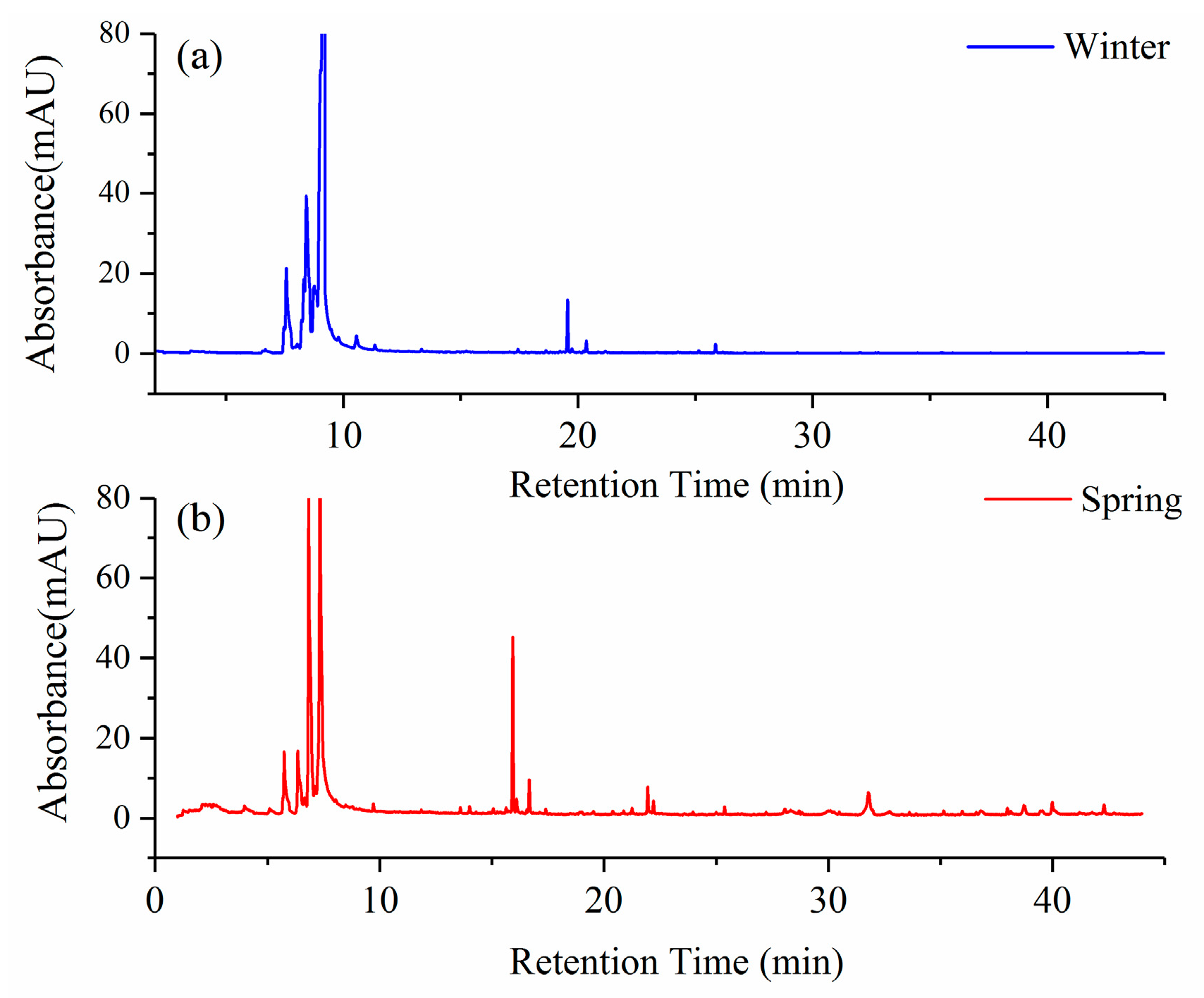
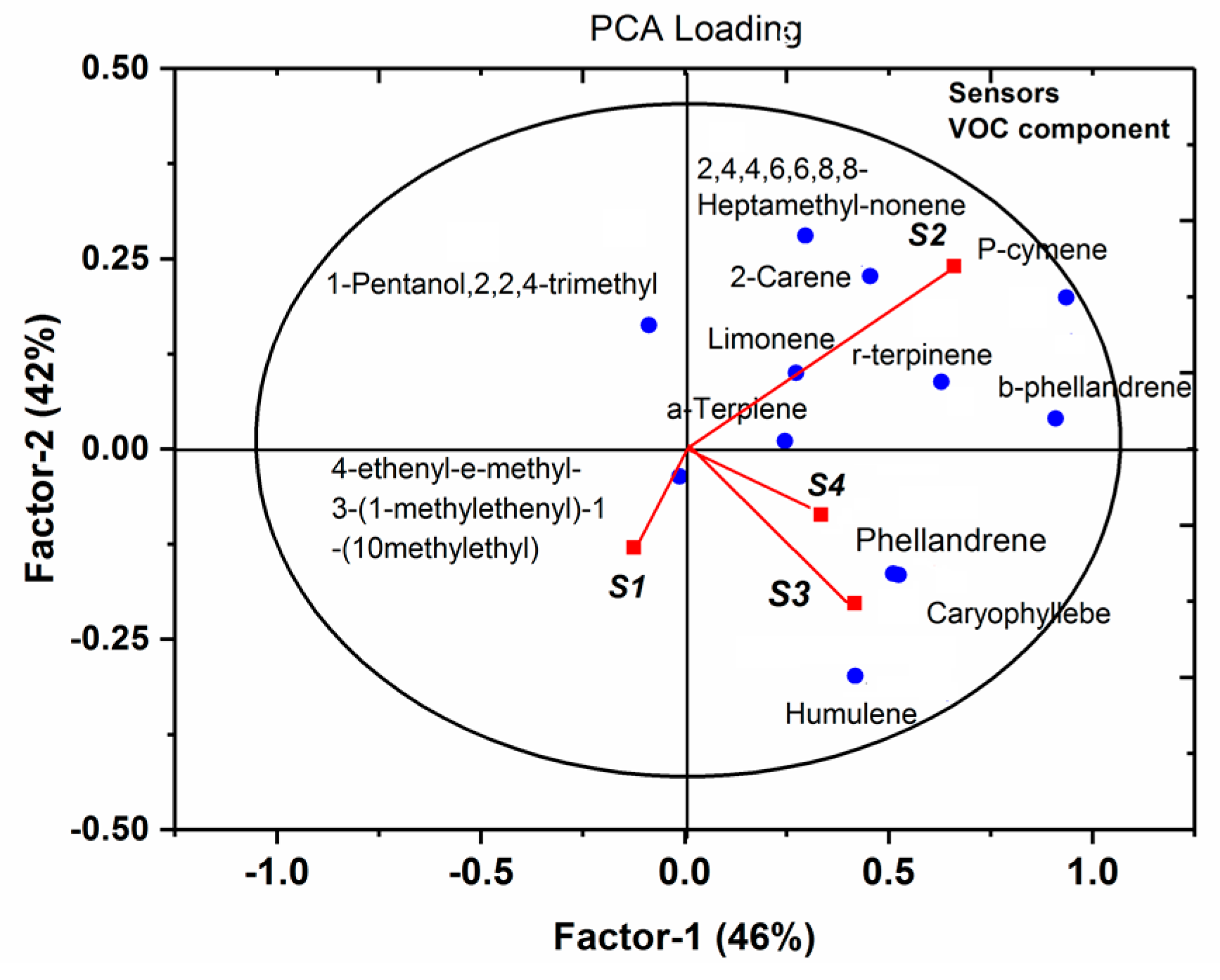
| No. | Name | Sensed Gases |
|---|---|---|
| 1 | MQ 3(S1) | Alcohol |
| 2 | MQ 138 (S2) | Volatile compounds (aldehydes, alcohols, ketones and aromatic compounds) |
| 3 | TGS 2602 (S3) | Volatile organic compounds and odorous gases |
| 4 | MQ 135 (S4) | Benzene, Alcohol |
| Items | Values |
|---|---|
| Sampling flow rate | 100 mL/min |
| Rinse flow rate | 100 mL/min |
| Temperature | 22 °C |
| Relative humidity | 45~48% |
| Carry gas for rinse | Clean air |
| Peak Number | Peak Name | VOCs Identified | ||||||
|---|---|---|---|---|---|---|---|---|
| Tomato Plants Infested by Aphids | Tomato Plants (Healthy) | Aphids Only | Chemical Structure | |||||
| RT * (min) | Area (%) | RT * (min) | Area (%) | RT * (min) | Area (%) | |||
| 1 | 2-Butanone | -- | -- | -- | -- | 1.847 | 63.75% |  |
| 2 | Triethylamine | -- | -- | -- | -- | 2.46 | 24.99% |  |
| 3 | Alpha-pinene | 7.27 | 0.1% | -- | -- | -- | -- |  |
| 4 | p-cymene | 9.31 | 8.56% | 7.47 | 8.03% | -- | -- |  |
| 5 | 2-Carene | 10.54 | 10.64% | 8.22 | 7.37% | -- | -- |  |
| 6 | Limonene | 11.23 | 4.02% | 8.76 | 4.64% | -- | -- |  |
| 7 | Alpha-phellandrene | 10.70 | 13.92 | 8.42 | 14.18% |  | ||
| 8 | Gamma-terpinene | -- | -- | 8.81 | 5.96% | -- | -- |  |
| 9 | Beta-phellandrene | 11.86 | 54.76 | 9.02 | 21.02 | -- | -- |  |
| 10 | Cyclohexene, 1-methyl-4-(1-methylethylidenen)- | -- | -- | 11.34 | 6.6% | -- | -- |  |
| 11 | 1-Pentanol, 2,2,4-trimethyl- | -- | -- | -- | -- | 12.53 | 5.03% |  |
| 12 | Linalool | 15.85 | 3.52% | -- | -- | -- | -- |  |
| 13 | Carveol | 18.85 | 1.04% | -- | -- | -- | -- |  |
| 14 | Cyclohexene, 4-ethenyl-4-methyl-3-(1-methylethenyl)-1-(1-methylethyl)-, (3R-trans)- | 24.59 | 1.55% | -- | -- | -- | -- |  |
| 15 | Caryophyllene | 26.96 | 9..82% | 20.35 | 1.2% | -- | -- |  |
| 16 | Humulene | 27.83 | 0.96% | 26.86 | 1.4% | -- | -- |  |
| 17 | Disulfide, bis(1,1,3,3-tertramethylbutyl) | -- | -- | -- | -- | 25.92 | 1.6% |  |
| 18 | 2,4,4,6,6,8,8-Heptamethyl-1-nonene | 33.60 | 0.77% | -- | -- | 32.83 | 0.66% |  |
© 2019 by the authors. Licensee MDPI, Basel, Switzerland. This article is an open access article distributed under the terms and conditions of the Creative Commons Attribution (CC BY) license (http://creativecommons.org/licenses/by/4.0/).
Share and Cite
Cui, S.; Inocente, E.A.A.; Acosta, N.; Keener, H.M.; Zhu, H.; Ling, P.P. Development of Fast E-nose System for Early-Stage Diagnosis of Aphid-Stressed Tomato Plants. Sensors 2019, 19, 3480. https://doi.org/10.3390/s19163480
Cui S, Inocente EAA, Acosta N, Keener HM, Zhu H, Ling PP. Development of Fast E-nose System for Early-Stage Diagnosis of Aphid-Stressed Tomato Plants. Sensors. 2019; 19(16):3480. https://doi.org/10.3390/s19163480
Chicago/Turabian StyleCui, Shaoqing, Elvia Adriana Alfaro Inocente, Nuris Acosta, Harold. M. Keener, Heping Zhu, and Peter P. Ling. 2019. "Development of Fast E-nose System for Early-Stage Diagnosis of Aphid-Stressed Tomato Plants" Sensors 19, no. 16: 3480. https://doi.org/10.3390/s19163480
APA StyleCui, S., Inocente, E. A. A., Acosta, N., Keener, H. M., Zhu, H., & Ling, P. P. (2019). Development of Fast E-nose System for Early-Stage Diagnosis of Aphid-Stressed Tomato Plants. Sensors, 19(16), 3480. https://doi.org/10.3390/s19163480





